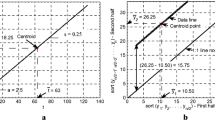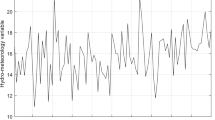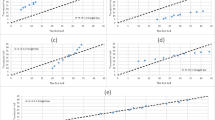Abstract
Systematic and random changes occur in any hydro-meteorological record and have significant effects on human activities on time and space scales. Although it is almost impossible to forecast the future behavior of any natural event accurately, researchers can identify trend on systematic variations and seasonality rather accurately with random residual parts. On the other hand, the role of trend is very significant in climate change studies and the Mann-Kendall test is the most employed method for trend identification. However, this method requires restrictive assumptions such as the data length, normality, and serial independence. Recently, innovative trend analysis (ITA) method is suggested for detailed trend determination and classification interpretations in a given time series without restrictive assumptions. In this study, an ITA-change boxes (CB) approach is proposed, taking into account quantitative changes with increasing or decreasing trends of the two half-time series obtained from the data. Given the periodicity of the hydro-meteorological data, the data group is used to obtain two half-time series instead of the data. This allows the researcher to numerically observe changes in trends beyond visualization. This approach assists to make more detailed interpretations about trend possibilities within a given time series. The applications of the proposed approach are presented for daily temperature and monthly rainfall and discharge records from Turkey, UK, and the USA.
Similar content being viewed by others
Avoid common mistakes on your manuscript.
Introduction
In a given time series, there may be changes in the form of an increasing or decreasing trend. There are a large number of trend determination studies in water quality, temperature, rainfall, streamflow, evapotranspiration, and similar time series records. In general, trend determination studies use Mann-Kendall, sequential Mann-Kendall, and Sen (1968) slope estimator coupled with Spearman Rho (Mann 1945; Kendall 1975; Kahya and Kalayci 2004; Partal and Kahya 2006; Bouza-Deaño et al. 2008, Agha and Şarlak 2016). These methods require some assumptions as normality, independence, and long data length, which are not taken into consideration in the most of applications. In order to alleviate the serial dependence assumption, pre-whitening process is proposed by some researchers for converting a given time series into its serially independent counterpart (von Storch 1995). However, the process is found controversial by different researchers due to removal of some portion of the trend (Yue et al. 2002; Yue and Wang 2002; Bayazit and Önöz 2007). Recently, Şen (2017a) proposed an over-whitening procedure, which provides better results than the pre-whitening approach.
On the other hand, Şen (2012, 2014, 2017b) proposed an ITA method, which does not need restrictive assumptions and ensures visual inspection possibility about trend existence. The method has been used in trend identification studies with water quality, evaporation, precipitation, temperature, streamflow, etc., data by different researchers (Sonali and Kumar 2013; Timbadiya et al. 2013; Elouissi et al. 2016; Güçlü et al. 2016; Öztopal and Şen 2016; Dabanlı et al. 2016).
The main purpose of this paper is to enhance the visual aspect of the ITA method through the innovative trend analysis-change boxes (ITA-CB) approach for better interpretations and detailed classification of trend possibilities in a given time series.
Innovative trend analysis-change boxes methodology
Prior to the explanation of ITA-CB, it is necessary to review the innovative trend analysis (ITA) method, which considers a time series as two half subseries from the parent time series. Each half is arranged in ascending order and then plotted against each other to see the scatter diagram. On the same scatter diagram, a 1:1 (45o) straight line is drawn as a presentation of no-trend indicator. If the scatter points are above (below) the 1:1 line, then there is increasing (decreasing) trend (see Fig. 1). If all scatter points are more or less parallel with the 1:1 straight line, then there is a monotonic increasing (decreasing) trend. In a single monotonic trend case, it is not necessary to look for “low,” “medium,” and “high” value groups, because the monotonic trend has a trend slope. On the other hand, if there are nonparallel scatters of points with increasing or decreasing trends then the data are divided as the low, medium, and high value groups for precision interpretations. The low, medium, and high value groups are arranged according to expert view or the variation over time is considered in three strictly objective manner by considering the first half-time series X; the mean \( \overline{X} \); and the standard deviation, S X , which helps to determine the ranges of low, medium, and high values as \( X<\overline{X}-{S}_X,\overline{X}-{S}_X<X<\overline{X}+{S}_X\mathrm{and}X>\overline{X}+{S}_X \), respectively.
In this article, an ITA-CB method is introduced to numerically visualize changes in a time series on ITA scatter graph. In this approach, unlike ITA, which calculates changes as quantity, the changes are calculated in percent according to the mean, and lower range and upper range indicate expected minimum and maximum change domains on a time series (see Fig. 2). Lower range and upper range values can be obtained from climate change scenarios published by climate research centers in IPCC reports, or are selected based on mean and standard deviation as described above. Suppose that x1, x2, ….., xn/2 (y1, y2, ……, yn/2) are values in the first half (second half) of a given time series in ascending order. First change ((y1 − x1)/(x1) × 100) is calculated and these operations are repeated n/2 times. At first, statistically, the minimum, average, and maximum changes in each group such as low, medium, and high are calculated from a given time series. Then, the changes are plotted in their own groups in a box graph well known in statistics science (see Fig. 2). In Fig. 2, the horizontal axis shows groups such as the low, medium, and high while vertical axis change percentages. Minimum, average, and maximum changes represent the minimum, average, and maximum change percentages for their group. If the mean line is close to the minimum (maximum) line, then there is a negative (positive) trend in the trend slope in Fig. 2. As a result, if the difference between the mean and maximum lines is small (large), the trend slope increases (decreases). Such a representation provides easier and detailed ways to numerically investigate possible changes.
Study areas and data
The application of ITA is presented for temperature, rainfall, and streamflow data from Turkey (Diyarbakır), UK (Oxford), and the USA (Mississippi) (see Fig. 3). Diyarbakir City is located on southeast of Turkey and with 20.4, 31.1, and 37.6 °C as minimum, average, and maximum July daily temperatures, respectively, from years 1972 to 2005. In total, there are 1054 daily temperature values measured by Turkish State Meteorological Service for the analysis of July temperature values of Diyarbakır City.
Oxford City is located on the southeast UK with 51.76 latitude and 1.26 longitudes and has 63 m altitude above mean sea level. The city has 0.5, 54.77, and 192.9 mm minimum, average, and maximum monthly rain values between from years 1853 to 2016. Total number of monthly rain measurement is 1968 and they are used in the analysis monthly rain values for Oxford. Oxfordshire is drier compared to other parts of UK, because it is more in the south and it does not get ocean-borne air masses.
Finally, Pascagoula River is located in the southeastern Mississippi, USA. The river flows into the Gulf of Mexico via Mississippi Sound, which is a sound along the Gulf Coast of the USA. Between 1931 and 2015, the minimum, average, and maximum monthly discharge values of the river are 20.22, 279.46, and 2003.98 m3/s. Measured by United Stated Geological Survey (USGS), 1020 discharge values are used to analyze the river monthly discharge. Statistical information on the observed stations is briefly given in Table 1.
Application and results
ITA and ITA-CB methods are applied for trend determination in the aforementioned records. The procedures as explained in the methodology section yield graphs for each location separately in Fig. 4.
Diyarbakır July daily temperature time series is divided into two halves, namely, the first half and second half (period). For example, if the minimum value for the first (second) half is 20.4 °C (20.6 °C) for Diyarbakır July daily temperature time series, then there is a 100×((20.4–20.6)/20.4) = 0.98% increasing change, and change percentages are calculated statistically to obtain the minimum, mean, and maximum change percentages (see Fig. 4a and b). The calculated percentages are plotted according to low, high, and “all” groups and demonstrated with minimum, mean, and maximum levels on the graph. The ITA-CB process is repeated for Oxford rainfall and Pascagoula River discharge monthly time series (see Fig. 4c–f).
In Diyarbakır, July daily temperature time series have an increasing trend on all groups (Fig. 4a). The low, high, and all groups have increasing trends with 2.04, 1.13, and 1.54% values, while the change ranges are from − 0.84 to 6.3% on all groups (Fig. 4b).
In the Oxford rainfall time series, the high group has a higher trend rate than the low group, but it seems as though there is a visually decreasing trend in the high group in Fig. 4c. This state is originated from perspective (scale) matter. Thus, minimum values have small quantities of change despite large change rates; it is a visual illusion. On the average, there are 0.21, 0.62, and 0.39% increasing values in the low, high, and all groups approximately while the change rates range from − 26.73 to 20% (Fig. 4d).
In the Pascagoula River monthly discharge time series, there is increasing trend in all groups. The change rates range from − 6.42 to 24.29% and 1.02 to 34.01%, and − 6.42 to 34.01% in the low, high, and all groups, respectively (Fig. 4f). The river has the biggest change rates in comparison with areas on the other locations. The average change rates for the low, high, and all groups are 9.32, 7.59, and 9.06%. According to the visual interpretations, the low group has a higher trend rate than the high group, but it seems as though the high group has a higher trend rate than the low group (see Fig. 4f). The summary of the percentages of change of groups is presented in Table 2.
Conclusion
ITA is a practically applicable method for identifying trends in a given time series for visual trend inspections, particularly with low, medium, and high hydro-meteorological data groups. In this paper, a modification of the ITA method is proposed for better interpretations and is proposed as namely the ITA-CB method that provides additional numerical interpretations when compared with the ITA method. This method gives a trend amount in percent for different groups in a given time series. Especially, trend calculation in percent helps determine trend in minimum value for visual inspection. Also, ITA-CB prevents misleading comments such as infinite change rate.
The applications of the proposed ITA-CB method are presented for temperature, rainfall, and streamflow data of Turkey (Diyarbakır), UK (Oxford), and the USA (Mississippi), respectively. The study areas and the data are selected from different regions of the world with different data types to demonstrate the effectiveness of the method. ITA-CB differs from visual presentation in Oxford rainfall and Pascagoula River discharge time series. This is due to the scale problem, which means that even if the minimum values have a high trend rate, they have a low trend quantity.
References
Agha OMAM, Şarlak N (2016) Spatial and temporal patterns of climate variables in Iraq. Arab J Geosci 9(4):302. https://doi.org/10.1007/s12517-016-2324-y
Bayazit M, Önöz B (2007) To pre-whiten or not to pre-whiten in trend analysis? Hydrol Sci J 52(4):611–624. https://doi.org/10.1623/hysj.52.4.611
Bouza-Deaño R, Ternero-Rodrìguez M, Fernàndez-Espinosa AJ (2008) Trend study and assessment of surface water quality in the Ebro River (Spain). J Hydrol 361(3-4):227–239. https://doi.org/10.1016/j.jhydrol.2008.07.048
Dabanlı İ, Şen Z, Yeleğen M, Şişman E, Selek B, Güçlü Y (2016) Trend assessment by the innovative-Şen method. Water Resour Manag 30(14):5193–5203. https://doi.org/10.1007/s11269-016-1478-4
Elouissi A, Şen Z, Habi M (2016) Algerian rainfall innovative trend analysis and its implications to Macta watershed. Arab J Geosci 9(4):303. https://doi.org/10.1007/s12517-016-2325-x
Güçlü YS, Şişman E, Yeleğen MÖ (2016) Climate change and frequency-intensity-duration (FID) curves for Florya station İstanbul. J Flood Risk Manag. https://doi.org/10.1111/jfr3.12229
Partal T, Kahya E (2006) Trend analysis in Turkish precipitation data. Hydrol Process 20(9):2011–2026. https://doi.org/10.1002/hyp.5993
Kahya E, Kalayci S (2004) Trend analysis of streamflow in Turkey. J Hydrol 289(1–4):128–144. https://doi.org/10.1016/j.jhydrol.2003.11.006
Kendall MG (1975) Rank correlation methods. Oxford University Press, New York
Mann HB (1945) Nonparametric tests against trend. Econometrica 13(3):245–259. https://doi.org/10.2307/1907187
Öztopal A, Şen Z (2016) Innovative trend methodology applications to precipitation records in Turkey. Water Resour Manag 31(3):727–737. https://doi.org/10.1007/s11269-016-1343-5
Sonali P, Kumar Nagesh D (2013) Review of trend detection methods and their application to detect temperature changes in India. J Hydrol 476:212–227. https://doi.org/10.1016/j.jhydrol.2012.10.034
Şen Z (2012) Innovative trend analysis methodology. J HydrolEng 17(9):1042–1046
Şen Z (2014) Trend identification simulation and application. J HydrolEng 19(3):635–642
Şen Z (2017a) Hydrological trend analysis with innovative and over-whitening procedures. Hydrol Sci J 62:1–12
Şen Z (2017b) Innovative trend significance test and applications. TheorApplClimatol 127(3-4):939–947. https://doi.org/10.1007/s00704-015-1681-x
Timbadiya P, Mirajkar A, Patel P, Porey P (2013) Identification of trend and probability distribution for time series of annual peak flow in Tapi Basin, India. ISH Int J HydrocarbEng 19(1):11–20
von Storch H (1995) Misuses of statistical analysis in climate research. In: Storch HV, Navarra A (eds) Analysis of climate variability: applications of statistical techniques. Springer, New York, pp 11–26. https://doi.org/10.1007/978-3-662-03167-4_2
Yue S, Wang CY (2002) Applicability of prewhitening to eliminate the influence of serial correlation on the Mann-Kendall test. Water Resour Res 38(6):4–1-4-7. https://doi.org/10.1029/2001WR000861
Yue S, Pilon P, Phinney B, Cavadias G (2002) The influence of autocorrelation on the ability to detect trend in hydrological series. Hydrol Process 16(9):1807–1829. https://doi.org/10.1002/(ISSN)1099-1085
Author information
Authors and Affiliations
Corresponding author
Rights and permissions
About this article
Cite this article
Alashan, S. An improved version of innovative trend analyses. Arab J Geosci 11, 50 (2018). https://doi.org/10.1007/s12517-018-3393-x
Received:
Accepted:
Published:
DOI: https://doi.org/10.1007/s12517-018-3393-x








